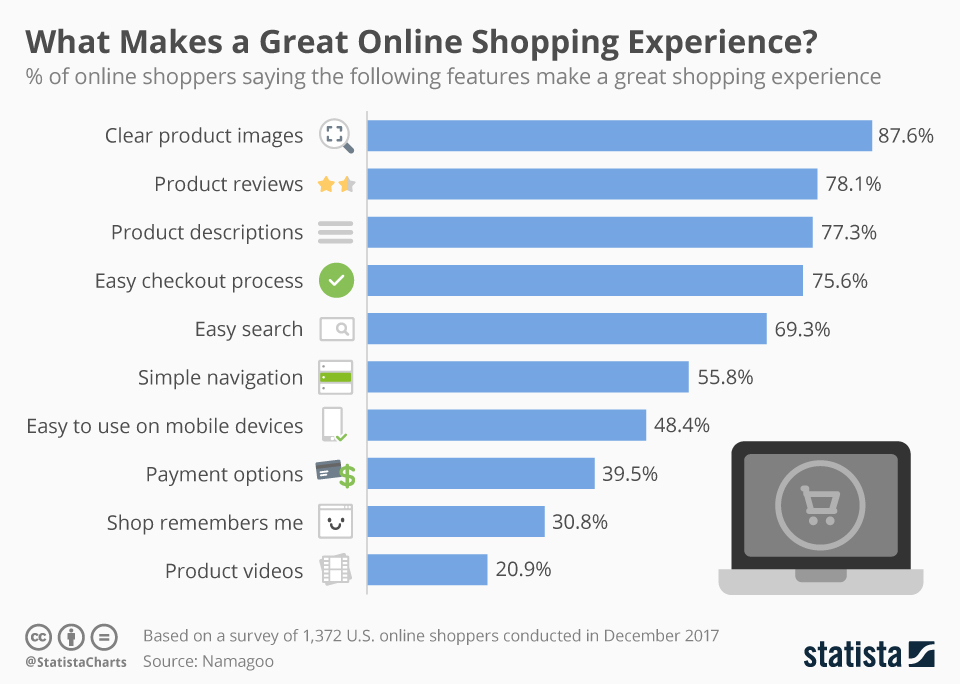- 03/14/2019
- Posted by: Mike O'Malley
- Category: country radio programming, radio programming, Talent

2018 was another big year for online shopping. Holiday spending alone totaled more than 120-billion dollars. Worldwide e-commerce this year is expected to reach 3.45-trillion dollars. So what drives online shopping satisfaction? And what can radio learn from online shoppers?
According to more than 1300 US online shoppers, here’s what makes a great shopping experience:

This bar graph is really about satisfying three basic needs: insight, ease of purchase, and personal connection. It’s not too much of a stretch to see how these needs can apply to any number of industries – including radio.
So let’s take a radio perspective. Specifically, let’s look at what radio can learn from online shoppers and how the the online shopping experience parallels a great radio listening experience.
Clear Product Images
For online shoppers, this is about understanding exactly what they’re going to get for their money. They can examine a product from different angles (literally). They can get specifics, ideas for potential uses and more so that the shopper can feel confident that the product is right for them.
Similarly, smart stations and talent will provide helpful and focused content. In execution this includes strong teases and promos that inform and excite. From a values standpoint this means aligning station and listener principles (think the number of “green companies” with sustainability as part of their DNA). And from a satisfaction perspective, how station listening adds value to life.
Product Reviews and Descriptions
Online reviews are the norm. 90% of online consumers check reviews before visiting a store. Half will read between 4 and 10 reviews before buying.
Meanwhile for the sellers, reviews provide marketing content. Reviews can strengthen brand identity and help distance a business from its competitors.
Stations and talent can reap similar benefits. Align the content with station fans while, at the same time, attaching the the station to something bigger. This can include anything from the music community to something that your core values. Demonstrate you’re a fan – music and/or values – with enthusiasm, stories and insights. Go even deeper on other platforms.
Easy Check-Out
Simplicity is the key – another thing radio can learn from online shoppers. Make your station/show easy to enjoy, share and participate in. Be sure all touch points are hassle and gimmick-free.
Easy Search/Navigation
Search is about information and speed. It’s estimated that Google processes over 63,000 inquiries per second and delivers search results in a fraction of that time.
As talent, provide entertainment and information that preempts searches. As a station, direct listeners to locations where more information is available. This makes retrieving information easier than wading through lengthy and confusing on-air instructions. Just remember not to do both.
Likewise create your own versions of “customers who bought this, also bought…”
Easy to Use on Mobile Devices
Almost 40% of all holiday e-commerce purchases were made on smart phones. Thus you’ll want to make smart phones your partners.
Insure listeners can connect with you effortlessly via voice, text, and social media. Encourage “tap to talk” communications. Regularly create new and engaging content that makes interacting with your station on mobile not only fun but addictive.
Painless (as possible) Payment Options
Everything has a cost. The key is to make the benefit greater than the whatever the price is. The greater the distance between cost and benefit, the better.
This is another lesson radio can learn from online shoppers. Back in the early 2000’s I created a few simple algebra formulas for programmers to serve as visual reminders of how to keep stations aligned with listeners. One of the formulas was EV>CL. Translated this equation means “The Entertainment Value must be Greater Than the Cost of Listening.”
So control your costs which include everything from irrelevant content to weak songs to material that runs counter to listener expectations.
They Remember Me!
Everybody likes to be recognized as someone special. For online shoppers this means remembering things like preferences, addresses, and preferred means of payment.
Radio’s version is watching listeners’ eyes light up when they recall how a talent remembered their name or a story they once shared. They’re also quick to share with others the times the talent gave them a candid look into their off-air life. Or when the talent shared something so personally meaningful that it was remembered weeks/months/years later.
So embrace one of radio’s strengths and paradoxes: the ability to communicate one-on-one with thousands of people simultaneously. Turn transactional encounters into personal ones by wholly inserting yourself into the process.
Product Videos
Whether you’re using them to sell, instruct, or entertain, videos can make a significant contribution to your show and brand.
Thus creating integrated on-air/online experiences makes good use of platforms built for visual engagement.
An Eye to the Future
Staying a step ahead of competitors often has its humble roots in simple observation. So the next time you or someone in your family does some online shopping, watch for and note positive and negatives triggers and take programming cues from this.
Similarly, whenever you see a piece related to customer satisfaction, take a moment to consider what you can glean from it.
Have another story of what radio (or any other business) can learn from online shoppers? Feel free to share. And be sure to let us know what’s been successful for you.
You’re on your way to being the Amazon of Radio/Air Talent.
Related: Episodic Content Lessons from a Bunch of Bananas
Chart: https://www.statista.com/chart/14012/features-making-a-great-online-shopping-experience/
Photo by Trent Yarnell on Unsplash
